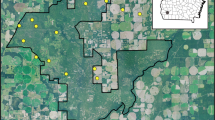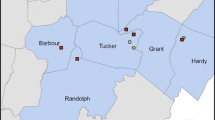Abstract
Despite having an arid climate, the Columbia River Basin of eastern Washington is one of the most important areas for breeding, migrating, and wintering wetland birds in the Pacific Northwest. Extensive farmland irrigation near the O’Sullivan Reservoir and other areas has raised water tables, resulting in closed canopies of emergent vegetation in what are now permanent, shallow wetlands. During 1994–95, we found that avian communities on vegetation-filled wetlands excavated to create open water had greater mean densities of dabbling and diving ducks (Anatidae), shorebirds, American coots (Fulica americana), and terns (Sterna spp.) than untreated control wetlands. Densities of yellow-headed blackbirds (Xanthocephalus xanthocephalus) were greater on excavated wetlands, while the densities of red-winged blackbirds (Agelaius phoeniceus), Sora (Porzana carolina), and Virginia rails (Rallus limicola) were greater on unaltered sites. Densities of marsh wrens (Cistothorus palustris) and other passerines were similar among excavated and control wetlands. Zooplankton biomass was greater on altered wetlands and generally greater in older excavations. We suggest that managers may design constructed wetland basins to improve population management of diverse wetland bird species by creating an appropriate mix of wetland habitats at the landscape level.
Similar content being viewed by others
Literature Cited
Bendell, B.E. and D.K. McNicol. 1987. Estimation of nektonic insect populations. Freshwater Biology 18:105–108.
Clark, R.G. and P.J. Weatherhead. 1951. The effect of fine-scale variations in agricultural land use on the abundance of red-winged blackbirds. Canadian Journal of Zoology 64:1951–1955.
Culver, D.A., M.M. Boucherle, D.J. Bean, and J.W. Fletcher. 1985. Biomass of freshwater crustacean zooplankton from length-weight regressions. Canadian Journal of Fisheries and Aquatic Sciences 42:1380–1390.
Daubenmire, R. 1970. Steppe vegetation of eastern Washington. Washington Agricultural Experimental Station, Washington State University, College of Agriculture, Pullman, WA, USA. Technical Bulletin 62.
English, W.R. 1987. Three inexpensive aquatic invertebrate samplers for the benthos, drift and emergent fauna. Entomology News 98:171–179.
Fassett, N.C. 1969. A Manual of Aquatic Plants. McGraw-Hill, Inc., New York, NY, USA.
Fleetwood, S.C., C.D. Steelman, and P.E. Schilling. 1978. The effects of waterfowl management practices on mosquito abundance and distribution in Louisiana coastal marshes. Mosquito News 38:105–111.
Gilbert, D.W., D.R. Anderson, J.K. Ringelman, and M.R. Szymcak. 1996. Response of nesting ducks to habitat and management on the Monte Vista National Wildlife Refuge, Colorado. Wildlife Monographs 131:1–44.
Glahn, J.F. 1974. Study of breeding rails with recorded calls in north-central Colorado. Wilson Bulletin 86:206–214.
Gollop, J.B. and W.H. Marshall. 1954. A guide to aging duck broods in the field. Mississippi Flyway Council, Minneapolis, MN, USA. Technical Section Report.
Hands, H.M., M.R. Ryan, and J.W. Smith. 1991. Migrant shorebird use of marsh, moist-soil, and flooded agricultural habitats. Wildlife Society Bulletin 19:457–464.
Harris, S.W. 1954. An ecological study of the waterfowl in the Potholes area, Grant County, Washington. American Midland Naturalist 52:403–432.
Hitchcock, C.L. and A. Cronquist. 1973. Flora of the Pacific Northwest. 1st ed. University of Washington Press, Seattle, WA, USA.
Hoag, J.C. 1980. Duck production and brood habitat use on canals, laterals, and drains in the Columbia Basin Irrigation Project, Washington. Master’s Thesis. Washington State University, Pullman, WA, USA.
Johnsgard, P.A. 1956. Effects of water fluctuations and vegetation change on bird populations, particularly waterfowl. Ecology 37:689–701.
Kadlec, J.A. and L.M. Smith. 1992. Habitat management for breeding areas. p. 509–610.In B.D.J. Batt, A.D. Afton, M.G. Anderson, C.D. Ankey, D.H. Johnson, J.A. Kadlec, and G.L. Krapu (eds.) Ecology and Management of Breeding Waterfowl. University of Minnesota Press, Minneapolis, MN, USA.
Kaminski, R.A. and H.R. Murkin. 1981. Evaluation of two devices for sampling nektonic invertebrates. Journal of Wildlife Management 45:493–496.
Kaminski, R.A. and H.H. Prince. 1981. Dabbling duck activity and foraging responses to aquatic invertebrates. Auk 98:115–126.
Kantrud, H.A. 1991. Effects of vegetation manipulation on breeding waterfowl in prairie wetlands—a literature review. U.S. Fish and Wildlife Service, Washington, DC, USA. Fish and Wildlife Technical Report 3.
Kaufmann, G.W. 1989. Breeding ecology of the Sora,Porzana carolina, and the Virginia rail,Rallus limicola. Canadian Field Naturalist 103:270–282.
Kirsch, L.M. 1969. Waterfowl production in relation to grazing. Journal of Wildlife Management 33:821–828.
Krapu, G.L. and K.J. Reinecke. 1992. Foraging ecology and nutrition. p. 1–29.In B.D.J. Batt, A.D. Afton, M.G. Anderson, C.D. Ankey, D.H. Johnson, J.A. Kadlec, and G.L. Krapu (eds.) Ecology and Management of Breeding Waterfowl. University of Minnesota Press, Minneapolis, MN, USA.
Krull, J.N. 1970. Aquatic plant-macroinvertebrate associations and waterfowl. Journal of Wildlife Management 34:707–718.
Mahaffy, L.A. 1986. Effects of open marsh water management on submerged aquatic vegetation utilized by waterfowl in Delaware. p. 323–332.In Proceedings of a Symposium on Waterfowl and Wetlands Management in the Coastal Zone of the Atlantic Flyway. Delaware Dept. of Natural Resources and Environmental Control, Dover, DE, USA.
McKinney, F. 1992. Courtship, pair formation, and signal systems. p. 214–250.In B.D.J. Batt, A.D. Afton, M.G. Anderson, C.D. Ankey, D.H. Johnson, J.A. Kadlec, and G.L. Krapu (eds.) Ecology and Management of Breeding Waterfowl. University of Minnesota Press. Minneapolis, MN, USA.
Miller, R.S. 1968. Conditions of competition between redwings and yellow-headed blackbirds. Journal of Animal Ecology 37:43–62.
Murkin, H.R., R.M. Kaminski, and R.D. Titman. 1982. responses by dabbling ducks and aquatic invertebrates to an experimentally manipulated cattail marsh. Canadian Journal of Zoology 60:2324–2332.
Murkin, H.R., P.G. Abbott, and J.A. Kadlec. 1983. A comparison of activity traps and sweep nets for samplign nektonic invertebrates in wetlands. Freshwater Invertebrate Biology 2:99–106.
Murkin, H.R., D.A. Wrubleski, and F.A. Reid. 1994. Sampling invertebrates in aquatic and terrestrial habitats. p. 349–369.In T.A. Bookhout (ed.) Research and Management Techniques For Wildlife and Habitats. Allen Press, Inc. Lawrence, KS, USA.
Needham, J.G. and P.R. Needham. 1962. A Guide to the Study of Fresh-Water Biology. McGraw-Hill, New York, NY, USA.
Page, L.M. and B.M. Burr. 1991. A Field Guide to Freshwater Fishes. Houghton Mifflin Company, Boston, MA, USA.
Pennack, R.W. 1978. Fresh-water Invertebrates of the United States. 2nd ed. John Wiley and Sons, New York, NY, USA.
Ringelman, J.K. and L.D. Flake. 1980. Diurnal visibility and activity of blue-winged teal and mallard broods. Journal of Wildlife Management 44:822–829.
Rumble, M.A. and L.D. Flake. 1982. A comparison of two waterfowl brood survey techniques. Journal of Wildlife Management 46:1048–1053.
Rundle, W.D. and L.H. Fredrickson. 1981. Impoundments for rails and shorebirds. Wildlife Society Bulletin 9:80–87.
SAS Institute, Inc. 1995. JMP Statistics and Graphics Guide version 3.1. SAS Institute, Inc., Cary, NC, USA.
Smock, L.A. 1980. Relationships between body size and biomass of aquatic insects. Freshwater Biology 10:375–383.
Stewart, R.E. and H.A. Kantrud. 1971. Classification of natural ponds and lakes in the glaciated prairie region. U.S. Fish and Wildlife Service. Washington, DC, USA. Research Publication 92.
Stott, R.S. and D.P. Olson. 1972. An evaluation of waterfowl surveys on the New Hampshire coastline. Journal of Wildlife Management 36:468–476.
USDA. 1994. Scientific and common plant names: state of Washington. United States Department of Agriculture, Soil Conservation Service, Spokane, WA, USA.
USDA. 1988. Western wetland flora: Field office guide to plant species. United States Department of Agriculture, Soil Conservation Service, West National Technical Center. Portland, OR, USA.
Voigts, D.K. 1976. Aquatic invertebrate abundance in relation to changing marsh vegetation. The American Midland Naturalist 95: 313–322.
Weller, M.W. 1981. Freshwater Marshes. University of Minnesota Press, Minneapolis, MN, USA.
Author information
Authors and Affiliations
Rights and permissions
About this article
Cite this article
Creighton, J.H., Sayler, R.D., Tabor, J.E. et al. Effects of wetland excavation on avian communities in eastern Washington. Wetlands 17, 216–227 (1997). https://doi.org/10.1007/BF03161410
Received:
Revised:
Accepted:
Issue Date:
DOI: https://doi.org/10.1007/BF03161410




